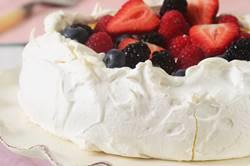PAVLOVA


Pavlova Recipe:
4 large (120 grams)egg whites
1 cup (200 grams) superfine (castor)sugar
1/2 teaspoon pure vanilla extract
1 teaspoon white vinegar
1/2 tablespoon cornstarch (corn flour)
Topping:
1 cup (240 ml) heavy whippingcream
1 1/2 tablespoons (20 grams) granulated whitesugar(or to taste)
1/2 teaspoon purevanilla extract
Fresh fruit - kiwi, strawberries, raspberries, blackberries, passion fruit, peaches, pineapple, or other fruit of your choice
Pavlova:Preheat oven to 250 degrees F (130 degrees C) and place rack in center of oven. Line a baking sheet with parchment paper and draw a 7 inch (18 cm) circle on the paper. Turn the parchment paper over so the circle is on the reverse side.
In the bowl of your electric mixer, with the whisk attachment, beat the egg whites on medium speed until they hold soft peaks. Start adding the sugar, a tablespoon at a time, and continue to beat, on high speed, until the meringue holds very stiff and shiny peaks. (Test to see if the sugar is fully dissolved by rubbing a little of the meringue between your thumb and index finger. The meringue should feel smooth, not gritty. If it feels gritty the sugar has not fully dissolved so keep beating until it feels smooth between your fingers). Beat in the vanilla extract. Sprinkle the vinegar and cornstarch over the top of the meringue and, with a rubber spatula, gently fold in. Spread the meringue inside the circle drawn on the parchment paper, smoothing the edges, making sure the edges of the meringue are slightly higher than the center. (You want a slight well in the center of the meringue to place the whipped cream and fruit.)
Bake for 60 to75 minutesor until the outside is dry and is a very pale cream color. Turn the oven off, leave the door slightly ajar, and let the meringue cool completely in the oven. (The outside of the meringue will feel firm to the touch, if gently pressed, but as it cools you will get a little cracking and you will see that the inside is soft and marshmallowy.)
The cooled meringue can be made and stored in a cool dry place, in an airtight container, for a few days.
Just before serving gently place the meringue onto a serving plate. Whip the cream in your electric mixer, with the whisk attachment, until soft peaks form. Sweeten with the sugar and vanilla and then mound the softly whipped cream into the center of the meringue. Arrange the fruit randomly, or in a decorative pattern, on top of the cream. Serve immediately as this dessert does not hold for more than a few hours.
Serves 6 to 8.
Pavlova (Pav) is a meringue cake that has a light and delicate crisp crust and a soft sweet marshmallow center. This lovely dessert is typically served with softly whipped cream and fresh fruit. There is a long standing debate about whether New Zealand or Australia invented this dessert, which has yet to be resolved. What we do know is that the name, Pavlova, was chosen in honor of the Russian ballerina, Anna Pavlova, who toured both New Zealand and Australia in 1926.
A Pavlova is a meringue, and it is important when making any meringue that the egg whites reach maximum volume, so make sure your mixing bowl and whisk are clean and free of grease. Since we need just the whites of the eggs, the eggs will need to be separated. It is easier to do this while the eggs are still cold. Once separated, cover the egg whites and let them come to room temperature before using (about 30 minutes). Cover and refrigerate the egg yolks for another use. I like to use superfine sugar (castor) when making this meringue as it dissolves faster into the egg whites than regular granulated white sugar. You can make your own by processing 1 cup (200 grams) granulated white sugar in your food processor until very fine, about 30 - 60 seconds.
To make the Pavlova first beat the egg whites until soft peaks form. Then add the sugar, one tablespoon at a time, and continue to beat until the meringue forms stiff and shiny peaks. Beat in the vanilla extract. With a rubber spatula, gently fold in the cornstarch and vinegar. (Adding these two ingredients will give the Pavlova a crust that is dry and crisp, with a soft marshmallow-like interior.)
Australian Stephanie Alexander in her excellent book "The Cook's Companion" gives us a few pointers on how to tell a good Pavlova, "if syrupy droplets form on the surface of the meringue, you'll know you have overcooked it; liquid oozing from the meringue is a sign of undercooking". So it is best to cook the meringue in a slow oven and then to turn off the oven and let it cool slowly.
The Pavlova can be made several days in advance of serving, if it is stored in a cool dry place, in an airtight container. A Pavlova is usually served with softly whipped cream and fresh fruit. (For a lower fat dessert, instead of whipped cream, try serving the Pavlova with a sorbet or fruit sauce (Raspberry,Blueberry, orStrawberrywould be nice) and fresh fruit.) Because of the sweetness of the meringue I like to offset the sweetness with tart flavored fruits. Passion fruit, kiwi, blackberries, blueberries, and raspberries are some of my personal favorites. Try to place the whipped cream and fruit on the meringue shortly before serving as the Pavlova will immediately start to soften and break down from the moisture of the cream and fruit.
No comments:
Post a Comment